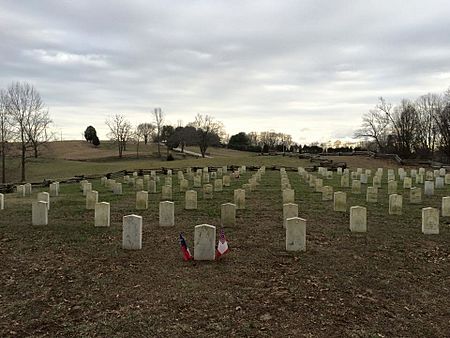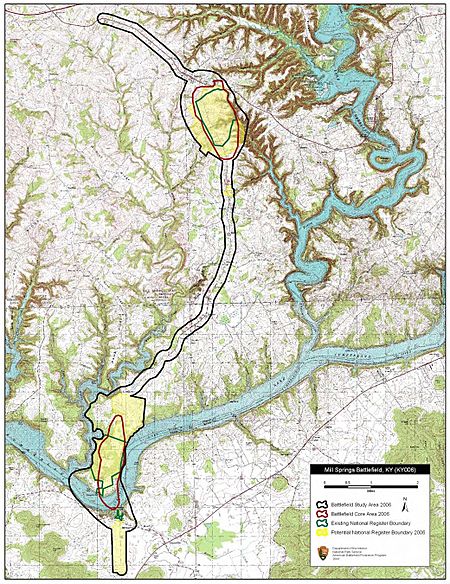Battle of Mill Springs facts for kids
Quick facts for kids Battle of Mill Springs |
|||||||
|---|---|---|---|---|---|---|---|
| Part of the American Civil War | |||||||
 Battle of Mill Springs by Currier and Ives |
|||||||
|
|||||||
| Belligerents | |||||||
| Commanders and leaders | |||||||
| George H. Thomas | George B. Crittenden Felix Kirk Zollicoffer † |
||||||
| Units involved | |||||||
| Kentucky, Indiana, Ohio, Minnesota and Tennessee infantry, cavalry and artillery regiments | Mississippi, Tennessee, Kentucky and Alabama infantry, cavalry and artillery regiments | ||||||
| Strength | |||||||
| 4,400 | 5,900 | ||||||
| Casualties and losses | |||||||
| 39 killed 207 wounded |
125 killed 404 wounded/missing |
||||||

The Battle of Mill Springs was a key fight during the American Civil War. It happened on January 19, 1862, in Kentucky. The Union side called it the Battle of Logan's Cross Roads. The Confederate side called it the Battle of Fishing Creek. This battle was an important victory for the Union army. It stopped an early Confederate plan to push into central Kentucky.
In late 1861, Confederate General Felix Kirk Zollicoffer was guarding a key mountain pass called Cumberland Gap. He moved his troops into Kentucky. He set up his winter camp at Mill Springs. Union General George Henry Thomas was ordered to stop the Confederates. He marched his troops to Logan's Crossroads. General Zollicoffer's boss, General George B. Crittenden, decided to attack the Union forces early.
On January 19, the Confederates attacked at dawn. They didn't know that some Union backup troops had just arrived. The Confederates had some early success. But the Union soldiers fought back hard. General Zollicoffer was killed during the battle. The Confederates tried another attack, but it failed. Union counterattacks pushed the Confeder Confederates back. They had to retreat all the way to Murfreesboro, Tennessee.
This battle was the first big Union victory of the war. People celebrated it a lot. But soon, other Union victories, like those by Ulysses S. Grant at Forts Henry and Donelson, became more famous.
Contents
Why Did the Battle of Mill Springs Happen?
In 1861, Kentucky was a "border state." It tried to stay neutral, meaning it didn't pick a side in the Civil War. But this neutrality was broken when both Union and Confederate armies moved into the state. This meant Kentucky became a battleground.
By early 1862, Confederate General Albert Sidney Johnston was in charge of all Confederate forces from Arkansas to the Cumberland Gap. His army was spread out. He had troops guarding the Tennessee and Cumberland rivers. He also had troops in Kentucky.
General Zollicoffer was supposed to guard the Cumberland Gap. But he moved his troops west into Kentucky. He wanted to be closer to other Confederate forces. He also wanted to control the area around Somerset. He set up camp on the north side of the Cumberland River at Mill Springs. This was a mistake because the south side was a better defensive spot. His commanders told him to move, but he couldn't. He didn't have enough boats to cross the river quickly. He was worried the enemy would attack while his troops were crossing.
Union General George H. Thomas was ordered to push the Confederates back across the Cumberland River. Thomas marched his troops through bad weather. He arrived at Logan's Crossroads on January 17. He waited for more Union troops to join him. General Crittenden arrived at Mill Springs and saw Zollicoffer's dangerous position. He decided to attack Thomas's army before all the Union forces could gather. He ordered Zollicoffer to attack the Union camp at dawn on January 19.
Who Fought at Mill Springs?
The battle involved soldiers from many states.
Union Forces
The Union army had soldiers from Kentucky, Indiana, Ohio, Minnesota, and Tennessee. These were infantry (foot soldiers), cavalry (soldiers on horseback), and artillery (soldiers with cannons).
Confederate Forces
The Confederate army had soldiers from Mississippi, Tennessee, Kentucky, and Alabama. They also had infantry, cavalry, and artillery.
What Happened During the Battle?
The Confederate march to Logan's Crossroads was tough. It rained, and the ground was muddy. The soldiers were cold and tired. Many of their old guns didn't work well in the wet weather. They lost the element of surprise because they were so slow.
Still, they attacked bravely. General Zollicoffer led from the front. They pushed back some Union troops at first. But the battlefield was confusing. It was dark, and gunsmoke filled the air. General Zollicoffer, wearing a white raincoat, rode too close to Union soldiers. He thought they were his own men. He was shot and killed, possibly by Union Colonel Speed S. Fry.
The death of their leader confused the Confederates. Their line fell back. But General Crittenden quickly rallied his men. He ordered another attack.
Then, General Thomas arrived on the Union side. He ordered his troops to advance. The Union soldiers fought hard. One Union regiment, the 9th Ohio, attacked the Confederate left side. This move decided the battle. The Confederate soldiers broke and ran. They retreated in a panic back to Mill Springs. General Crittenden couldn't stop them.
They quickly crossed the Cumberland River. They left behind cannons, wagons, horses, and all their dead and wounded. Their retreat continued for about 50 miles.
What Was the Result of the Battle?
The Battle of Mill Springs was a clear Union victory. Not many soldiers died compared to later battles. The Union lost 39 killed and 207 wounded. The Confederates lost 125 killed and 404 wounded or missing.
General Crittenden's military career was ruined. He was accused of not doing his job well. His army was broken up. He later resigned from the army.
This battle, along with another one called the Battle of Middle Creek, broke the main Confederate defense line in eastern Kentucky. These Union victories allowed the United States to push the war further south into Tennessee.
Visiting the Mill Springs Battlefield Today
The Mill Springs battlefield is a historic place you can visit today. It's located in Pulaski and Wayne counties, near Nancy, Kentucky. The original town of Mill Springs is now across Lake Cumberland.
On the Wayne County side, you can still see two buildings from the time of the battle. These are the Brown-Lanier House and the West Metcalfe House. You can take guided tours there in the summer.
In Pulaski County, part of the battlefield is a park called Zollicoffer Park. It's named after the Confederate general who died there. This park has a mass grave for Confederate soldiers. There's also a separate cemetery, the Mill Springs National Cemetery, for Union soldiers.
The battlefield covers about 105 acres. It's considered a very important historic landmark. A famous tree, called the Zollie Tree, marked where General Zollicoffer fell. The tree is gone now, but its stump is marked. Groups like the American Battlefield Trust have helped protect over 685 acres of the battlefield.
In 2006, the Mill Springs Battlefield Visitors Center and Museum opened. You can learn a lot about the battle there. They also hold special events like candlelight tours and reenactments. In 2019, the battlefield officially became a National Monument. This means it's now part of the National Park Service.




